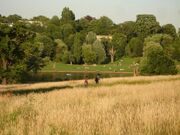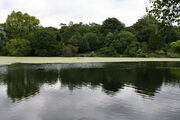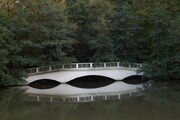
Highgate model boating pond near Parliament Hill
Hampstead Heath (locally known as "the Heath") is London's largest ancient parkland, covering 3.2 km² (320 ha; 791 acres). This grassy public space sits astride a sandy ridge, running from Hampstead to Highgate, which rests on a band of London clay. The Heath is rambling and hilly, embracing ponds, recent and ancient woodlands, a lido, playgrounds, a training track and in addition it adjoins the stately home and grounds of Kenwood House. In the south of Hampstead Heath lies Parliament Hill, the park's focal point and one of the highest points in London: the commanding view from its summit is protected by law.
The Heath has long been a popular place for Londoners to walk and take the air. Running along its eastern perimeter lies a chain of ponds - including three open-air public swimming pools - which were originally reservoirs for drinking water formed from the River Fleet; and the northern Kenwood area is a location of a Site of Special Scientific Interest, the smallest such site in London. Until February 2007, Kenwood House in the north of the park held lakeside concerts. The Heath is managed by the City of London Corporation, and lies mostly in the London Borough of Camden, with a small area in the London Borough of Barnet.
History[]

Southern entrance to Hampstead Heath
The Heath enters the history books in 986 when Ethelred the Unready granted one of his servants five hides of land at "Hemstede". This same land is later recorded in the Domesday Book as held by the monastery of St. Peter’s at Westminster Abbey in 1086 and by then is known as the "Manor of Hampstead". Westminster held the land until 1133 when control of part of the manor was released to one Richard de Balta; then, during Henry II's reign the whole of the manor was given over to the private hands of an Alexander de Barentyn, the king's butler. Manorial rights to the land remained in private hands until the 1940s when they lapsed under Sir Spencer Pocklington Maryon Wilson, though the estate itself was passed on to Shane Gough, 5th Viscount Gough.
Over time, plots of land in the manor were sold off for building, particularly in the early 19th century, though the Heath remained mainly common land. The main part of the Heath was acquired for the people by the Metropolitan Board of Works, with Parliament Hill added in 1888 after it was purchased for the public for £300,000, Golders Hill in 1898 and Kenwood House with its grounds in 1928.
From 1808 to 1814 Hampstead Heath hosted a station in the shutter telegraph chain which connected the Admiralty in London to its naval ships in the port of Great Yarmouth.
The Heath has been managed by the City of London Corporation since 1989, having been previously managed by the GLC and then Camden Council.
Geography[]
The Heath sits astride a sandy ridge resting on a band of London Clay running from east to west. As the sand was easily penetrated by rainwater which was then held by the clay, a landscape of swampy hollows, springs and man-made excavations was created.
Most of the Heath (approx 85%) lies in the borough of Camden, with the rest, the Extension, lying in Barnet.
Public transport near the Heath include London Overground stations at Gospel Oak to the south, Hampstead Heath and London Underground stations at Hampstead and Belsize Park to the west, Golders Green to the north, and Highgate and Archway to the east. Bus routes serve many of the roads around the Heath.
The wildlife includes kingfishers, jackdaws and ring-necked parakeets. Pipistrelles and Daubenton's bats may be seen over the ponds.
Areas of the Heath[]
The Heath covers 800acre and has a number of distinct areas. "Boudicca's Mound", near the present men's bathing pond, is a tumulus where, according to local legend, Queen Boudicca (Boadicea) was buried after she and 10,000 other Iceni soldiers were defeated at Battle Bridge. However, earlier drawings and paintings of the area show no mound other than a 17th Century windmill.
In the south of the Heath, and on the southern slopes of Parliament Hill, is the Gospel Oak Lido open air swimming pool, with a running track and fitness area to its north.
Highgate and Hampstead Ponds[]

A pond on Hampstead Heath
There are over 25 ponds on Hampstead Heath, mostly collected into two distinct areas. On the east (Highgate) side is a series of eight former reservoirs originally dug in the 17th and 18th centuries. These include two single-sex (the men's and ladies' bathing ponds) swimming pools, a model boating pond, a wildlife reserve pond and a fishing lake.
On the other side of the Heath, towards South End Green in the south-west, are three further ponds, one of which is the 'mixed pond', where members of both sexes may swim. These ponds are the result of the damming in 1777 of Hampstead brook, one of the sources for the Fleet River, by the Hampstead Water Company who had been formed in 1692 to meet London's growing water demand.
In 2004, the City of London Corporation, which operates the Heath, tried to close the ponds on the grounds that they were an unsustainable drain on their expenses and posed a health risk to swimmers. The swimmers challenged this and won a victory in the High Court. To defray costs, the Corporation introduced a charge for swimmers of £2 per session, £1 for concessions. There was some opposition to this and some of the ticket machines were vandalized.
Parliament Hill Fields[]
Parliament Hill Fields lies in the south and east of the Heath; it became an official part of the Heath in 1888. It contains various sporting facilities including an athletics track and tennis courts. Parliament Hill itself is considered to be the focal point of the Heath, with the highest part of it known as "Kite Hill" due to its popularity with kite flyers. The hill is around 321 feet (98 m) high and is notable for the excellent views it provides of the London skyline. It is possible to see the skyscrapers of Canary Wharf and the City of London, along with St Paul's Cathedral and other landmarks, all together in one view, some of which are protected views. The main staff yards for the management of the Heath are located at Parliament Hill Fields.
Kenwood[]

Kenwood House false bridge
The area to the north of the Heath is the Kenwood estate and House - a total area of 0.5 km² (50 ha; 112 acres) which is maintained by English Heritage. This was joined to the Heath when it was donated to the nation by Lord Iveagh, on his death in 1927, and opened to the public in 1928. One third of the estate is a Site of Special Scientific Interest, particularly the ancient woodlands, designated by English Nature. These are home to many birds and insects and the largest Pipistrelle bat roost in London.
The original house dates from the early 17th century. The orangery was added in about 1700.
The popular summer lakeside concerts, which started in 1951, ceased in February 2007 after protests from local residents. However, the return of the concerts was announced in March 2008 after English Heritage agreed a number of changes with Camden Council, notably with regards to noise levels.
The Vale of Health[]
The Vale of Health is a small hamlet (named "Hatchett's Bottom" until 1801): accessed via a small lane off East Heath Road, it is surrounded entirely by the Heath. It is now one of the most expensive residential areas in the world.
Extension[]
The Extension is an area which lies to the north-west. It does not share the history of common and heathland of the rest of the Heath. Instead it was created out of farmland, largely due to the efforts of Henrietta Barnett who went on to found Hampstead Garden Suburb. Its farmland origins can still be seen in the form of old field boundaries, hedgerows and trees.
Golders Hill Park[]
Golders Hill Park is a formal park adjoining the West Heath part of the Heath and is on the site formerly occupied by a large house which was bombed during World War II. Its main characteristic is an expanse of grass, but it also has a formal flower garden with a duck pond and a separate water garden, which leads onto a separate area for deer, near to a recently-renovated small zoo. The zoo has alpacas, maras, red-legged seriemas and white-naped cranes. There are also tennis courts and a putting green.
Unlike the rest of the Heath, Golders Hill Park is closed at night.
Hampstead Heath Constabulary[]
The "Hampstead Heath Constabulary" is a group of 12 constables with trained dogs who have been responsible for patrolling the park 24 hours a day since 1992.
They are attested as constables under Article 18 of the Ministry of Housing and Local Government Provisional Order Confirmation (Greater London Parks and Open Spaces) Act 1967 and Sec. 29 and Schedule 4 of the Police Act 1996. This authorises them to enforce the Hampstead Heath bylaws, and allows them full police powers on the Heath. Any significant incidents or crimes on the Heath are handed over to the Metropolitan Police, the regional police force for London.
Activities[]
The Heath is home to a range of activities, including 16 different sports. It is used by walkers, runners, swimmers and kite-flyers, and is regarded as the home of cross-country running in Britain. There is an annual 5k run through the Heath organised by Umbrella, and until February 2007 Kenwood held a series of popular lakeside concerts.
The West Heath is one of the most notable and safest night-time cruising grounds in London. George Michael has revealed that he cruises on the Heath; an activity he then parodied on the Extras Christmas Special.
Swimming takes place all year round on two of the three natural swimming ponds: the men's pond which opened in the 1890s, and the ladies’ pond which opened in 1925. The mixed pond is only open from May to September, though is the oldest, having been in use since the 1860s.
Facilities include an athletics track, a pétanque pitch, a volleyball court and eight separate children's play areas including an adventure playground.
Culture[]
The feature film, Scenes of a Sexual Nature (2006), directed by Ed Blum, was shot entirely on Hampstead Heath. Notting Hill (1999) featured scenes shot at the Heath, located primarily around Kenwood House.
Hampstead Heath was featured on the television programme Seven Natural Wonders as one of the wonders of the London area, with a focus on Parliament Hill to the south. The episode was presented by Bill Oddie, who lives in nearby Gospel Oak, and watches birds there regularly.
In 2005, Giancarlo Neri's sculpture The Writer, a 9-metre tall table and chair, was exhibited on Hampstead Heath.
Whilst living in London, Karl Marx and his family would take regular Sunday picnics on the Heath.
In the comedy show, Bo' Selecta, The Bear lived in a treehouse on Hampstead Heath and would continually complain of being kept awake at night by 'the bummers'.
John Atkinson Grimshaw, Victorian era painter, painted an elaborate night-time scene of Hampstead Hill in oils. Hampstead Heath also provided the backdrop for the opening scene in Victorian writer Wilkie Collins' novel The Woman in White.
A post-apocalyptic Hampstead Heath is the site of the village of Ham in Will Self's The Book of Dave.
Hampstead Heath is the primary setting for the 1983 short novel "The Purple Runner" by Paul Christman (Highgate Lane Press, Boulder, CO). The appearance of a mysterious disfigured runner of incredible talent intrigues the habitués of the heath. This book is considered one of the greatest running novels of all time, having become a cult classic (and very expensive to purchase).
The Hampstead Heath website is here.
The Heath and Hampstead Society website is [1]
| This page uses Creative Commons Licensed content from Wikipedia (view authors). That Wikipedia page probably contains more information. |